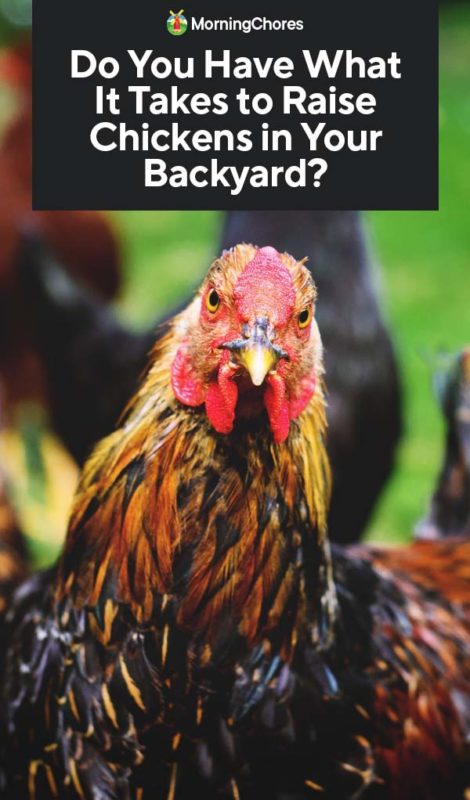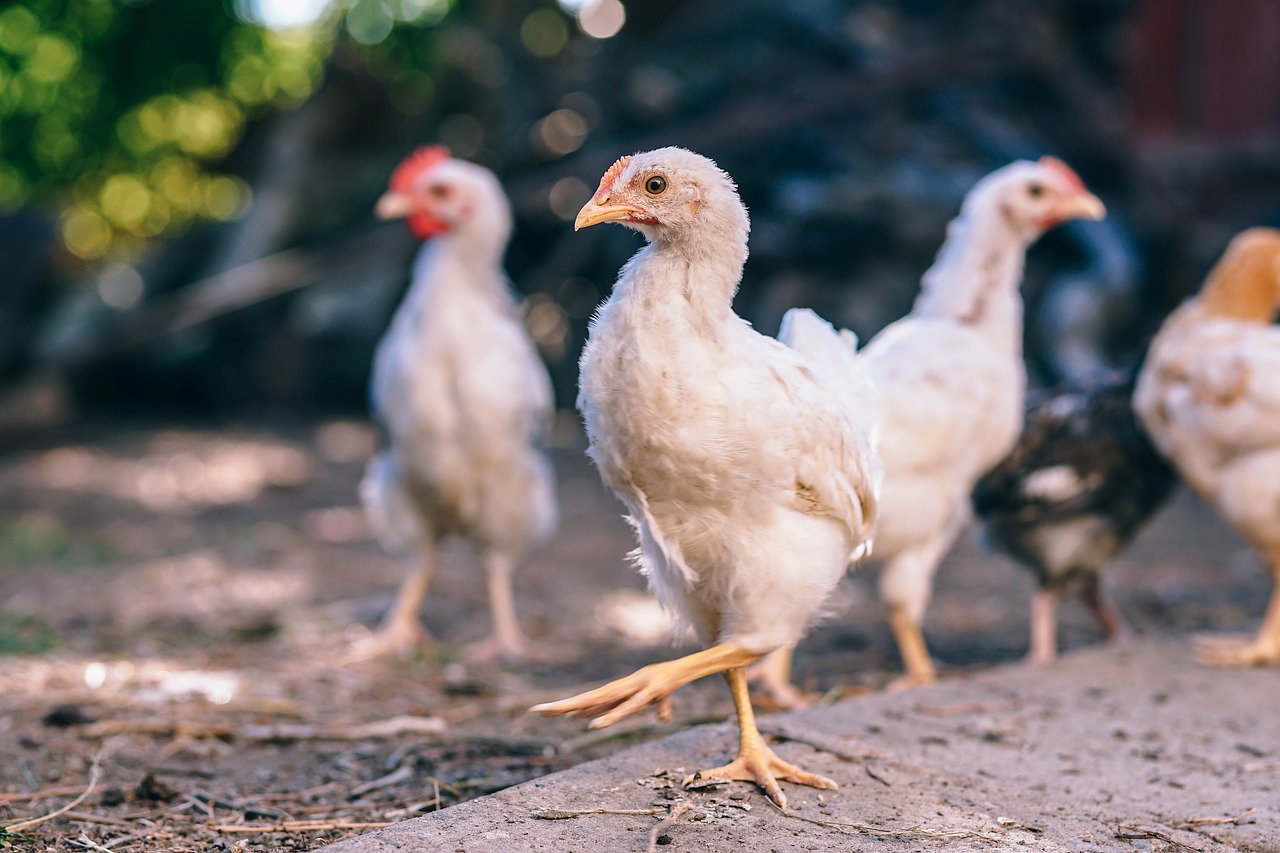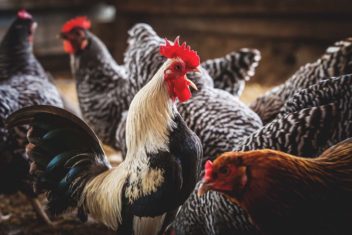Before heading out on the journey of raising backyard chickens, it’s important to ask the right question and that is:
Are you allowed to raise chickens in your area?
According to some people, there should be no problem. Having pet chickens should be like having any other pet animals such as cats and dogs. But the truth is that many suburban authorities and municipalities do not permit keeping chickens.
Even if you’re allowed to keep chickens in the area you live, you’ll be a given a long list of conditions and rules to comply with. This can range from the number of chickens you can keep to the design of the chicken coop.
You can save yourself from coming across quite a lot of trouble if you have the know-how of all the rules before building a coop and bringing your feathered friends to their new home.

The Legality of Keeping Backyard Chickens

Backyard chickens were a common sight in America in the early 20th century. Easy to breed, this domestic animal didn’t occupy much space and a small stock was enough to supply the entire family meat and eggs with minimal expenses.
Besides this, they were used to fulfill many of their dietary requirements and supplied many food staples.
So, what changed?
So how did the backyard chickens vanish from the scene?
By the middle of the 20th century, food production had become an organized industry and grocery stores were regularly supplied with poultry and eggs. Now, people could easily buy meat and eggs from supermarket to home and conveniently freeze the poultry – thanks to the refrigerator.
It was no longer necessary to go through the hassle of raising chickens just so you could have a hearty breakfast of omelets!
Simultaneously, during the affluent years’ post World War II, modern American suburban areas were established. There was a need to promote these developments as a suave, urbane, and cosmopolitan place to live.
Doing away with the rural tradition of rearing farm animals was one way to take these communities forward. There was no place for backyard chickens as they were viewed as a nuisance. The farm animals were seen as a threat to public health and also viewed as something noisy and smelly.
Today, however, raising backyard chickens has proven to be worthwhile. With the ushering of organic food and growing health concerns, the trend of raising chickens is becoming popular.
While you’re too eager and keen to start this endeavor, don’t forget to have a peep into the rules and regulations covering the raising of chickens.
Common Restrictions Related to Backyard Chickens
There are varying laws for each community. Some laws will not permit you to keep chickens at all while others will allow you to rear them provided you meet some conditions.
A 2008 report by the University of New Mexico studied various ordinances in 25 cities allowing people to raise chickens under some conditions. The report highlighted the following common themes:
1. Number of Chickens Allowed
There is a limit on the number of chickens that can be kept in a household as per local rules. This is specified either by a flat number of birds allowed i.e. 3, 4 or by using lot size.
2. Regulation of Roosters
Many communities will not allow you to raise roosters because they are too noisy and may disturb the neighbors. However, the rule will not affect those people wishing to raise chickens for eggs. It’s a common misconception that a rooster is needed for a hen to lay eggs.
3. Required Fees and Permits
Many municipalities require you to have a permit to keep chickens. In some cases, the payment comprises of an annual or one-time fee.
4. Containment Requirements
Some municipalities would require you to always keep your chickens confined in an outdoor run or a coop. This means that free-ranging is not allowed.
5. Regulations Related to Chicken Enclosures
There might be some rules regarding how a coop has to be built as well as the material which will go in making it. Before construction, you might need building permits as well as the approval of coop plans.
6. Setback Requirements for Coops
This will require you to maintain some distance in between outdoor runs, chicken coops, and neighboring properties. These requirements vary greatly and in communities having small lot size.
7. Restrictions Regarding the Slaughtering of Chickens
Some residential areas may deem slaughtering of chickens as illegal. Those who want to raise chickens for meat or wish to cull a hen if it doesn’t lay eggs would have to be mindful of the no-kill policy.
8. Nuisance Clauses
Chicken keeping is regulated by prohibiting nuisances resulting from improper maintenance and care of backyard chickens. Such regulation will strictly address issues such as noise, odor, and several conditions attracting pests and rodents, and disposal of manure.
How to Keep Chickens Legally
You need to dig a little deeper in your local zoning laws to see whether you can keep chickens at your place of residence or not. Then, you can have a look at any special regulations which can have an effect on building chicken housing.
Your property will be categorized as either a business, residential, agricultural, or any other. What does it mean?
Read about it out below:
Agricultural Property
This means that you can raise chickens without encountering any trouble. On your paperwork, you should be able to find a notice about Right to Farm bill. The Right to Farm bill states that legal and recognized methods of farming can be adopted and implemented at any time in the zone.
Residential or Residential/Agriculture/Other Type
If it is any of the above or if you have leased and rented your home, you’ll need to find out further as to what is allowed. Landlords may have certain additional requirements other than the local ordinances. Hence, read your lease agreement or talk it out with the landlord regarding pets or livestock.
Before you begin raising chickens, there are two laws and ordinances you need to be mindful about:
1. Laws Concerning the Ownership of Animals
There might be some limits placed on the sex and number of birds as well as the location of chicken coops on your property. In some areas, the amount of property you own as well as the closeness to your neighbors can determine if you can keep birds and if you can, then how many. You may also need to acquire written permission from your neighbors.
2. Laws That Restrict the Types of Housing Or Pens
These deal with issues such as needing a permit to build a chicken coop, or getting it inspected.
Find out what you are allowed to do from the right sources. If you recently bought your home, your deed and sales agreement will have zoning details listed on them.
If you can’t figure out the zoning category of your property, go to your city or township hall and have a look at the zoning map. In some places, you can request to get a copy or you can purchase it. In some township/city halls, you might need to look at a large wall map or in books.
Larger communities may also have a planning board that deals with issues related to zoning. In smaller areas, such as counties and villages, a county clerk or any animal control officer will answer any queries related to keeping animals. Issues pertaining to the construction of shelters and building fences are handled by another government unit.
If it’s possible for you, get a copy of the ordinances or laws so you can keep referring to them as per need. If you own a copy, you can show it to any neighbor who contests your right to keep animals or the number of animals you may legally own.
Warning:
Just because some people in your neighborhood are raising chickens, this doesn’t mean you can too.
It may or may not be legal. They may have taken them before there was a zoning change (people having animals before a zoning change are generally allowed to keep them afterward too). It may also be that some are raising chickens illegally.
Even if you’re told by your neighbors or your retailers that it’s fine to raise chickens in your neighborhood, it’s better to avoid any worse consequence by going to the right sources, acquiring legal information, and then taking the right decision. And when you’re officially allowed to raise chickens in your backyard, nothing could be more charming than that!
The Cost of Raising Chickens
Having a chicken in your backyard providing you with fresh eggs is a dream we all love to fulfill one day! However, this dream cannot be built on thin air. You have to do the proper planning so that your lofty business idea benefits you and doesn’t cost you more than it profits!
These days, we have to consider two factors:
- Rising cost of living
- Time value of money
So, those of us who are planning to one day become the proud owners of a chicken farm should first consider how this will all work out.
Do you pay for yourself or are you provided with some subsidies? More importantly, is all this hassle worth going through? Or are you better off buying eggs and poultry meat from your nearby supermarket?
How much does it cost to raise chickens in your backyard depends on the types of chicken you keep and how you’re looking after them.
Before you even start thinking about the design of a chicken coop, ask yourself two questions. These two questions will determine the cost of keeping the chickens:
- Do you want enough profit from chickens so that their own costs are paid for, from it?
Or
- Do you want chickens just as an addition to your home, occasionally providing you with eggs?
The cost of everything we buy these days will increase in the days to come. Hence, anyone who is planning to raise chickens should be realistic and practical when going ahead with the plan. The prices of birds depend greatly on their type and breed.
Here’s what you need to know:
Chicken Breeds
Your cheapest bet would be ex-battery hens bought through the regional Welfare Trust. You can get these around $6 per hen. Battery hens are those which lay the cheap eggs most commonly bought at grocery stores. The trend of adopting these hens is gaining popularity in Australia and UK and is fast growing in the U.S. too. If you live in the vicinity of a farm, you can contact them and offer to adopt a few hens.
Hybrids are colorful variants of chickens, developed for greater egg production. Point of lay pullets, a breed of chicken is sold from 16 weeks onwards. They can cost anywhere from $11 and $31. This is an enormous price range offering you various choices in between.
It would cost you cheaper if you were to buy directly from a commercial breeder as compared to a place which has brought them in. Similarly, old chickens will be an inexpensive option.
However, you’ll not be making huge savings as you’ll also need to invest in feeders, chick drinkers, heat lamps, and chick crumbs. You’ll need to care for these birds for up to 5 months before they can start laying eggs.
Pure breeds can have varying prices with a hatching egg costing you $2 and a point of lay costing you $30. Some breeds can even cost you $62 and upwards.
Some of the options available to you, other than buying from a breeder, are buying from sale pens at poultry auctions and poultry shows. These venues can provide you options within $25 to $30 range. Sometimes, in specialist sales, you can expect exhibition-quality stock prices to sky-rocket and hence each bird can cost $126 – $187!
Some poultry outlets claim to have completed the full vaccination program for their birds. This expensive procedure can be one of the reasons for the escalating price of birds.
However, if the person you’re purchasing from has a good reputation and has kept a few, exclusive chickens in a clean environment, vaccination may not entirely be necessary. If you want to protect your chickens from any specific disease, then they must be vaccinated before they get 5 days old with a vaccine that costs around $20 and comes in 1,000 doses.
Chicken Housing
Housing poultry is a big expense. Feeders, drinkers, and a starter pack of a house can all take the cost $300 upwards. It seems like a good, impressive deal. But you should be careful about the quality of the house. Some houses are fragile and not durable. It is a pity to invest your hard-earned money in a flimsy housing structure that has to be replaced after a few years.
If you pay for good quality, it will be beneficial for you in the long run, so buy the best chicken house you can afford within your means.
If you’re opting for elaborate and ornate chicken houses, they might cost you thousands of dollars. You could also find more feasible options for around $370-$550. A good quality coop can cost you around $370 and can easily accommodate a few birds. If you need to install fencing, you might need to spend at least $60 more.
A useful litter means dust-extracted shavings and comes in bales costing $7-$10 per bale. Parasite prevention products also need to be used. They can be helpful in eradicating pests and red mites. These products need to be used regularly and can cost around $11–$12.
Food
Drinkers and feeders have a vast array of choices among them. You can get hold of a plastic font drinker for $5 to $6. Feeders will cost you around the same but galvanized drinkers might cost you more.
Chicken feed will also contribute to ongoing expenses. A 20kg bag of poultry layer pellets can be priced anywhere from $10 to $15.
An organic feed will be pricier. Wheat is a more feasible option starting at $9 for a 20-kg bag but you’ll mostly find it priced between $10 and $11. Mixed corn consisting of oats and maize will cost you $1 more.
If your poultry also houses a rooster along with the chickens, then you’ll need hen saddles to protect the chickens from rooster’s spurs. Depending on the size, they can cost you from $11 to $15 so budget for them too.
Routine Care
This is an essential expense too and includes regular deworming. A 60g pot of Flubenvet is available from $18 in the market and can be sufficient for as many as 20 chickens. Nowadays, however, many manufacturers provide feed fortified with Flubenvet. This can be quite convenient for chicken breeders.
Another expense you would need to consider is livestock louse powder. A tub of this product can cost you around $12 and is helpful in dealing with fleas and lice. An anti-mite spray works in the same way and so do pour-on drops. It depends on which one you opt for.
Be mindful of the fact that whenever your chickens are feeling a bit under the weather, they need to be provided with proper veterinary treatment as well as a course of antibiotics. Vet consultation fee is an added expense you need to account for. A vet can charge you from $12 to $40. The anesthesia used at the vet’s clinic for your chicken can cost approximately $12 so factor this too in your list of expenses.
Think about what you can afford to take out from your pocket for raising chickens. Then calculate what would be the actual costs.
You may also find some additional costs which you could not even have considered on your own. For example, the destruction of the plants caused by your beloved feathered pets can add to your expenses. Care must be taken that the plants are protected by a chicken wire.
And there can be many other unexpected expenses too. With livestock in the backyard, how can any predator not come near it? A predator can damage the coop. From repairing any damages such as dug holes to buying locks for additional security, be prepared for unforeseen expenses to come flying in your monthly budget.
If you factor in all the time and amount of labor needed to raise chickens, it might appear that getting eggs from the supermarket is more economical. However, there’s one thing though that can never be estimated and yet it is pretty valuable. To you, your chickens will be priceless.
The joy of raising healthy animals, providing them with a safe environment, all the while getting the benefit for procuring organic eggs, makes the whole experience unbeatable! You know how your chickens are being fed and most importantly, the pleasure of consuming those eggs is worth all the efforts you make while raising chickens.
And if you’re a pet lover, you’re also at peace knowing the safe conditions in which you are raising chickens. These points don’t have any monetary value of their own but they sure do measure heavily when you’re considering the costs of raising your own chickens.
How Much Space Is Required to Raise Backyard Chickens?
The answer is simple: it depends on the number of chickens you plan to keep. But there are several other factors that go beyond this common sense. And as a chicken owner, you need to keep certain things in mind before planning how much space you should provide to the chickens.
Most people have set a standard space for backyard chickens, i.e. 4 sq. ft of coop space per chicken with 10 sq. ft per chicken to let it run. However, there’s a lot more to know besides allocating this standard rule of thumb. The space required to raise healthy chickens depends on the following factors:
Chickens Also Have Their Personal Space!
Interestingly, chickens have different personalities. Their individual requirements differ too. While some chickens are comfortable sharing space with others, the rest of them prefer enjoying their own personal space. Since each breed of chicken makes up an entirely different flock, their dynamics demand more space as compared to the other breeds of chickens.
Easy Access to Water and Poultry Feeder
Sometimes, keeping the poultry feeder inside the coop doesn’t make sense because it occupies a lot of space. Also, this gives a chance to the chickens to poop in it while roosting. This lack of space may further cause health and hygiene issues. You need to find the most appropriate way to give adequate space to your chickens by placing the water container and feeder where it is accessible to the chickens.
Roost Spacing
Chickens need ample space to sleep, spread their wings, and move to roost without jumping onto the poultry feeders, water containers, or nesting boxes. However, chickens don’t require a lot of roost space. Once they have been provided with the maneuvering room, they don’t occupy a lot of space.
Larger Space Means Less Poop Management
The more space your chickens will have, the less hectic it will be to clean their poop. While roosting, they do it the most. Therefore, you’ll have to decide if you want to consider the coop as their roosting area or choose a separate area for roosting.
The Length of Time Your Chickens Are Inside the Coop
This depends on your daily schedule. How often would you like to let them out from the coop? If you’re too busy to let them run outside the coop, it means that the coop should be big enough so that the birds can run around throughout the day without being confined.
The Number of Roosters You Plan to Keep
Getting one rooster for your flock doesn’t really increase the space required. However, if you plan to add a second rooster, this will change the dynamics and will require a bigger space. That’s because multiple roosters divide the flock into separate groups of chickens and each rooster claims his territory.
How Much Work Is Required to Raise Backyard Chickens?
As you begin to raise chickens, you might often have this question in your mind, “Will it take a lot of time and energy to raise my backyard flock?” And once you know the essentials of raising chickens, you’ll notice that there really isn’t a lot of work involved in keeping these pets happy and healthy.
However, this doesn’t mean that you don’t have to do anything with the chickens after getting them the right housing. Naturally, there are several responsibilities attached to raising these birds. So, if you’ve ever had pets before, the responsibilities of keeping chickens will seem quite familiar to you. And you’ll think for sure that there’s no hard work involved.
All you need to do is to provide a little bit of daily care to the chickens, such as feeding them the right way at the right time, keeping a check on their health, cleaning them up, etc. Interestingly, if you compare these tasks to an active dog that requires you to take it for regular walks, chickens take minimum time and effort to be raised.
To schedule your routine in carrying out daily and weekly chicken chores, have a look at the following tasks you’ll be required to perform:
NOTE: These are chores required from you to raise 3 chickens. If you have more than 3 chickens in your backyard, you’ll have to adjust your schedule accordingly.
Daily Chores
(Total Time Required: 10 Minutes from the Entire Day)
1. Open Up the Chickens in the Morning
Just as the sun rises, your chickens would be desperate to come out from their coop for an outdoor run. Sometimes, you’d hear them as soon as you wake up! So, this is the first thing to be done before even feeding them. Once you let them out, you can go back to sleep again. You can perform the remaining chores after that.
2. Provide Fresh Water and Food
Here’s something important to know: if you keep water and food inside their coop, there are high chances that the chickens may just dump the water everywhere. Secondly, coops usually have limited space, and thus, it’s not a practical option to keep water and food inside the coop. It’s better to use a poultry feeder outside the coop. Also, this makes it worthwhile to let the chickens out during a specific timeframe so that they can be fed well.
Each morning, you can add a large measure of food to the poultry feeder. However, avoid giving them extra food for the day because this may attract small critters to the pen.
Since laying hens require a lot of water to make eggs, they can easily drink 2-3 cups of water a day. This means that the water shouldn’t only be ample enough to fulfill the daily water intake requirement of the chickens, it should also be fresh (and refilled every other day) so it remains free from any debris.
3. Scrape and Remove Droppings from the Coop
If there are any droppings on the floor of the coop, scooping those out every morning will help with the good hygiene and health of the chickens. Throw the droppings into any spare bucket or directly to a compost pile. Though it’s natural to miss a day in case you’re getting late for work, it’s recommended to never leave this chore to the next day. That’s because it’s tougher to remove two days’ chickens’ droppings than to remove the poop the same day.
But there’s another worthwhile reason to clean the coop daily: this lets you check the health of the chickens on a daily basis. For instance, if their poop doesn’t look normal, there might be a health issue with one or more of your chickens. This way, you know when to show one or all of the chickens to the vet.
4. Observe the Chickens and Find Out If There Are Any Health Issues with Them
Of course, it isn’t a chore as you’ll just love to see your chickens run from one corner of the backyard to the other! However, during the colder months, none of us would want to go outside in the chilly weather. That’s when your responsibility begins: even in winter, you’ll have to spend a few minutes to make sure that the entire flock is drinking and eating properly.
To do this, you don’t need to take out extra time from your busy schedule. While you’re feeding them in the morning or tidying up their coop, see it for yourself: are they acting normally? If yes, then you’re simply doing a great job raising healthy chickens!
5. Provide Scraps and Treats to the Chickens
There’s always a lot to supplement the chickens’ diet with something they’ll love to eat. Some examples include scratching grains, garden scraps, and treats consisting of worms. Besides this, you’ll have to make sure that you’re never out of food supplies. This will require you to schedule your trips to chicken food stores depending on the number of chickens you want to keep.
6. Collect the Eggs
This one is one of the most interesting and rewarding chores of raising chickens. Gather the eggs daily. Though there isn’t any hard and fast rule, you can check their nesting box in the early evening. But make sure you check it when there isn’t any squawking sound as the sound means that the hens are still laying eggs.
7. Bring All Chickens into the Coop and Lock the Door
Once the chickens are ready to roost inside the coop, you’ll have to shut the door of the coop and lock it. This essential chore keeps predators away from them. This way, you can make sure that your birds will remain secure throughout the night.
NOTE: These daily tasks should never be missed. If you’re going elsewhere for a few days, you should get a chicken sitter to carry out these chores on a daily basis.
Weekly Chores
(Total Time Required: 30 Minutes – 1 Hour per Week)
1. Clean the Pen
It’s normal to see debris sticking to the pen. This often includes the uneaten garden scraps and other foods for chickens. You’ll have to clean the debris from the pen. This will take just a few minutes.
2. Add Some Litter to the Chickens’ Coop
Though there are different kinds of litter to be used for this purpose, wood shavings are a good option. Add smaller parts of these wood shavings inside the coop while adding some more (for example, half of the small bucket). You’ll have to perform this task weekly so it remains fresh.
3. Clean the Water Font
The trough may often get scummy due to intense heat during the summer. To sanitize and clean the water fount, you can use a scouring pad or a brush with stiff bristles along with a water solution made of chlorine bleach.
Here’s how to make this solution: take a clean jug and add a half cup of bleach in it. Fill the entire jug with water. Replace its cap. Combine these ingredients by shaking the jug well. You’ll have to rinse the font with this mixture thoroughly.
4. Pick Each Chicken and Inspect If There Are Any Health Issues
Though you can observe symptoms of any illness in any of your chickens when they’re drinking, eating, or just running, it’s crucial to have a closer look at each of them. That’s because examining each bird closely will help you identify if there are any leg mites, feather loss, eye infections, and other such conditions in it.
However, before you handle all chickens individually, you should learn how to hold the chickens without harming them.
Here’s how to catch them right away and that too without consuming a lot of time: Wait until its dark so the chickens have settled to roost or are half asleep. Slowly and softly, hold them and check them if they need treatment. Now, place them back in the coop. This time is ideal to check them out because they don’t have to suffer a lot of stress.
Other Regular Tasks
(Total Time Required: 2 Hours in 1 Year, 4 to 6 Times Throughout the Year)
1. Clean the Coop Well
After a few months, you’ll have to remove the litter from the coop and scrub the coop. You can either use a homemade bleach-water solution or go for the one available in the market. To make the coop pest-free, use a poultry protector spray on the coop. When it dries, you’ll be required to add litter to the coop so it becomes ready for the chickens to rest inside.
2. Get the Pen and Coop Ready for the Winter
Throughout the year, you’ll have to make sure that the pen, as well as the coop, remains clean for the flock. This requires you to add fresh straw over the straw that had already been added in the pen. Besides this, install an infrared bulb (make sure its low-watt) inside the chickens’ coop. Other activities to keep the birds warm include installing a cover over their coop and heating the water font so they drink water that’s a bit warmer. When the winter days have gone, you can pack all these items till you need them again next year.
Behavior That Might Discourage You from Raising Chickens
What could be a better hobby than keeping chickens? You’re getting the eggs. Plus, you just love your chickens. But still, things can go quite wrong. And that’s natural. People might feel discouraged to raise chickens because of a few problems. However, there are solutions to every problem. So, while raising chickens, you may come across the following problems but the solutions are worth trying:
1. Roosters Make a Lot of Noise
Undoubtedly, roosters are noisy. This may disturb not only your neighbors but your chickens too. Though it’s impossible to keep your rooster silent, you can manage to keep it as silent and less irritating as possible.
Here’s how:
Usually, roosters crow if they notice any changes in the level of lighting. So, if your rooster tends to be noisy at night, the excess light might be the reason. Darken the coop by covering its windows or lights. Another option is to keep the coop’s lights switched on – the entire night. This way, your rooster will experience the least changes in light. Thus, it will not crow as intensely as it used to.
2. Roosters Attack!
Let’s admit this: roosters are dominating. They also begin to attack people. This is one of the reasons why a lot of chicken lovers are just afraid of raising chickens as they’d have to keep a rooster too. And a rooster can actually be dangerous for them! However, once you identify “why” roosters attack people, you’ll find a solution easily.
Roosters will attack you if they perceive you as an aggressive person. Wearing floppy shoes or having a bucket and swinging it in front of a rooster may be an offensive action for a rooster. As the chickens’ guardian, the rooster will accept the challenge and may attack you.
To tame your rooster, here’s what you should do:
Wear protective clothing. As your rooster gets ready to attack, catch him and hold him firmly till he realizes that you’re the one in charge. However, you need to stay as persistent as you can. Also, keep in mind that this method will work effectively for a young rooster.
3. Pecking Is Common Among Chickens

This is quite a disturbing problem for those who own and raise chickens. Cannibalistic birds keep pecking at the feathers, heads, and toes of each other. Since chickens naturally imitate one another, once all the chickens adapt this behavior, they begin to peck each other continuously. If this behavior cannot be managed or controlled easily, this may result in flesh injuries or even death of the chickens.
However, here’s the solution:
Since poor nutrition, excessive lighting, and overcrowding are the main causes of cannibalism among chickens, make sure there are dim lighting and ample space for the birds. Besides this, you can hire an expert who trims the beaks of offending chickens and removes the injured chickens from the aggressive ones.
Can YOU Raise Chickens?
By now you should have a clear understanding of whether or not you can raise chickens, legally. You should also be cognizant of how much it will cost you, and the vital question – can you afford to and will you be able to take good care of them.
Keep an eye open for our next post where we will discuss choosing the right breeds.












